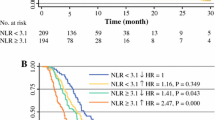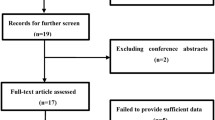Abstract
Purpose
The neutrophil-to-lymphocyte ratio (NLR) is associated with decreased overall survival in patients with pancreatic adenocarcinoma (PAC) in studies including few minority patients. We investigated the association between NLR and survival in patients with advanced PAC in an ethnically diverse population.
Methods
We retrospectively evaluated 226 patients with advanced PAC treated at Montefiore Medical Center between 2006 and 2015. Adjusted Cox proportion hazard regression models were utilized to derive effect estimates for survival duration.
Results
Patients with a NLR ≤ 5 (126 patients, median age 66 years) were more likely to be non-Hispanic Black (30.8% vs. 20%), while patients with a NLR > 5 (70 patients, median age 66 years) were more likely to be non-Hispanic White (21.4% vs. 12.2%) or Hispanic (44.3% vs. 34%). A NLR > 5 compared with a NLR ≤ 5 was significantly associated with a worse overall survival when adjusted for a priori and exploratory variables from the univariate analysis (median survival 7.4 vs. 12 months, HR 1.650, 95% CI 1.139, 2.390).
Conclusions
In an ethnically diverse population, elevated NLR is an independent marker of poor prognosis and a potentially valuable factor in driving therapeutic decisions and defining prognosis for patients in the locally advanced or metastatic for PAC setting, meriting investigation in prospective clinical trials.


Similar content being viewed by others
References
Siegel RL, Miller KD, Jemal A. Cancer statistics, 2016 (in eng). CA: Cancer J Clin. 2016;66(1):7–30. https://doi.org/10.3322/caac.21332.
Malvezzi M, Bertuccio P, Levi F, La Vecchia C, Negri E. European cancer mortality predictions for the year 2014. Ann Oncol. 2014;25(8):1650–6. https://doi.org/10.1093/annonc/mdu138.
C. S. Yabar and J. M. Winter, “Pancreatic cancer: a review,” Gastroenterology Clinics of North America, vol. 45, no. 3, pp. 429-445, 9// 2016, https://doi.org/10.1016/j.gtc.2016.04.003.
Burris HA 3rd, et al. Improvements in survival and clinical benefit with gemcitabine as first-line therapy for patients with advanced pancreas cancer: a randomized trial in eng. J Clin Oncol : Off J Am Soc Clin Oncol. 1997;15(6):2403–13. https://doi.org/10.1200/jco.1997.15.6.2403.
D. D. Von Hoff et al., Increased survival in pancreatic cancer with nab-paclitaxel plus gemcitabine(in eng) N Engl J Med, vol. 369, no. 18, pp. 1691-703, Oct 31 2013, 10.1056/NEJMoa1304369.
T. Conroy et al., “FOLFIRINOX versus gemcitabine for metastatic pancreatic cancer,” (in eng), The New England journal of medicine, vol. 364, no. 19, pp. 1817-25, May 12 2011, 10.1056/NEJMoa1011923.
Le N, Sund M, Vinci A. Prognostic and predictive markers in pancreatic adenocarcinoma (in eng). Digest Liver Dis: Off J Italian Soc Gastroenterol Italian Assoc Stud Liver. 2016;48(3):223–30. https://doi.org/10.1016/j.dld.2015.11.001.
T. M. Bauer et al., Carbohydrate antigen 19-9 is a prognostic and predictive biomarker in patients with advanced pancreatic cancer who receive gemcitabine-containing chemotherapy: a pooled analysis of 6 prospective trials in eng, Cancer, vol. 119, no. 2, pp. 285-92, Jan 15 2013, 10.1002/cncr.27734.
M. Haas et al., “Prognostic value of CA 19-9, CEA, CRP, LDH and bilirubin levels in locally advanced and metastatic pancreatic cancer: results from a multicenter, pooled analysis of patients receiving palliative chemotherapy,” (in eng), J Cancer Res Clin Oncol, vol. 139, no. 4, pp. 681-689, 2013, https://doi.org/10.1007/s00432-012-1371-3.
Elinav E, Nowarski R, Thaiss CA, Hu B, Jin C, Flavell RA. Inflammation-induced cancer: crosstalk between tumours, immune cells and microorganisms (in eng). Nat Rev Cancer. 2013;13(11):759–71. https://doi.org/10.1038/nrc3611.
Grivennikov SI, Greten FR, Karin M. Immunity, inflammation, and cancer (in eng). Cell. 140(6):883–99, Mar 19 2010. https://doi.org/10.1016/j.cell.2010.01.025.
Proctor MJ, McMillan DC, Morrison DS, Fletcher CD, Horgan PG, Clarke SJ. A derived neutrophil to lymphocyte ratio predicts survival in patients with cancer (in eng). Br J Cancer. 2012;107(4):695–9. https://doi.org/10.1038/bjc.2012.292.
Proctor MJ, et al. An inflammation-based prognostic score (mGPS) predicts cancer survival independent of tumour site: a Glasgow Inflammation Outcome Study (in eng). Br J Cancer. 2011;104(4):726–34. https://doi.org/10.1038/sj.bjc.6606087.
Templeton AJ, et al. Prognostic role of neutrophil-to-lymphocyte ratio in solid tumors: a systematic review and meta-analysis in eng. J Natl Cancer Inst. 2014;106(6):dju124. https://doi.org/10.1093/jnci/dju124.
Stotz M, et al. “Increased neutrophil-lymphocyte ratio is a poor prognostic factor in patients with primary operable and inoperable pancreatic cancer,” (in eng). Br J Cancer. 2013;109(2):416–21. https://doi.org/10.1038/bjc.2013.332.
Xue P, Kanai M, Mori Y, Nishimura T, Uza N, Kodama Y, et al. Neutrophil-to-lymphocyte ratio for predicting palliative chemotherapy outcomes in advanced pancreatic cancer patients (in eng). Cancer Med. 2014;3(2):406–15. https://doi.org/10.1002/cam4.204.
Kou T, Kanai M, Yamamoto M, Xue P, Mori Y, Kudo Y, et al. Prognostic model for survival based on readily available pretreatment factors in patients with advanced pancreatic cancer receiving palliative chemotherapy. Int J Clin Oncol. 2016;21(1):118–25. https://doi.org/10.1007/s10147-015-0864-x.
Goldstein D, et al. nab-Paclitaxel plus gemcitabine for metastatic pancreatic cancer: long-term survival from a phase III trial(in eng). J Natl Cancer Inst. 2015;107(2). https://doi.org/10.1093/jnci/dju413.
Wang-Gillam A, Hubner RA, Siveke JT, von Hoff D, Belanger B, de Jong FA, et al. NAPOLI-1 phase 3 study of liposomal irinotecan in metastatic pancreatic cancer: final overall survival analysis and characteristics of long-term survivors (in eng). Eur J Cancer. 2019;108:78–87. https://doi.org/10.1016/j.ejca.2018.12.007.
Murthy VH, Krumholz HM, Gross CP. Participation in cancer clinical trials: race-, sex-, and age-based disparities(in eng). Jama. 2004;291(22):2720–6. https://doi.org/10.1001/jama.291.22.2720.
Azab B, Camacho-Rivera M, Taioli E. Average values and racial differences of neutrophil lymphocyte ratio among a nationally representative sample of United States subjects (in eng). PLoS One. 2014;9(11):e112361. https://doi.org/10.1371/journal.pone.0112361.
QuickStats. age-adjusted death rates* for top five causes of cancer death,(dagger) by race/Hispanic ethnicity - United States, 2014 (in eng). MMWR Morb Mortal Wkly Rep. 2016;65(37):989. https://doi.org/10.15585/mmwr.mm6536a10.
Silverman DT, et al. Why do Black Americans have a higher risk of pancreatic cancer than White Americans? Epidemiology Cambridge, Mass. 2003;14(1):45–54. https://doi.org/10.1097/01.ede.0000034393.39604.ff.
Bellin E, Fletcher DD, Geberer N, Islam S, Srivastava N. Democratizing information creation from health care data for quality improvement, research, and education-the Montefiore Medical Center Experience. Acad Med : J Assoc Am Med Coll. 2010;85(8):1362–8. https://doi.org/10.1097/ACM.0b013e3181df0f3b.
Lash TL, Silliman RA. A comparison of the National Death Index and Social Security Administration databases to ascertain vital status. Epidemiology Cambridge, Mass. 2001;12(2):259–61.
Park HS, Lee HS, Park JS, Park JS, Lee DK, Lee SJ, et al. Prognostic scoring index for patients with metastatic pancreatic adenocarcinoma. Cancer Res Treat. 2016;48(4):1253–63. https://doi.org/10.4143/crt.2015.400.
Hsieh MM, Everhart JE, Byrd-Holt DD, Tisdale JF, Rodgers GP. Prevalence of neutropenia in the U.S. population: age, sex, smoking status, and ethnic differences(in eng). Ann Intern Med. 2007;146(7):486–92.
D. Reich et al., Reduced neutrophil count in people of African descent is due to a regulatory variant in the Duffy antigen receptor for chemokines gene(in eng) PLoS Genet, vol. 5, no. 1, p. e1000360, 2009, 10.1371/journal.pgen.1000360.
Hanahan D, Weinberg RA. Hallmarks of cancer: the next generation,(in eng). Cell. 2011;144(5):646–74. https://doi.org/10.1016/j.cell.2011.02.013.
Hanahan D, Coussens LM. Accessories to the crime: functions of cells recruited to the tumor microenvironment(in eng). Cancer Cell. 2012;21(3):309–22. https://doi.org/10.1016/j.ccr.2012.02.022.
Swierczak A, Mouchemore KA, Hamilton JA, Anderson RL. Neutrophils: important contributors to tumor progression and metastasis (in eng). Cancer Metastasis Rev. 2015;34(4):735–51. https://doi.org/10.1007/s10555-015-9594-9.
Bausch D, Pausch T, Krauss T, Hopt UT, Fernandez-del-Castillo C, Warshaw AL, et al. Neutrophil granulocyte derived MMP-9 is a VEGF independent functional component of the angiogenic switch in pancreatic ductal adenocarcinoma (in eng). Angiogenesis. 2011;14(3):235–43. https://doi.org/10.1007/s10456-011-9207-3.
Grosse-Steffen T, Giese T, Giese N, Longerich T, Schirmacher P, Hänsch GM, et al. Epithelial-to-mesenchymal transition in pancreatic ductal adenocarcinoma and pancreatic tumor cell lines: the role of neutrophils and neutrophil-derived elastase in eng. Clin Dev Immunol. 2012;2012:720768. https://doi.org/10.1155/2012/720768.
Bellone G, et al. Tumor-associated transforming growth factor-beta and interleukin-10 contribute to a systemic Th2 immune phenotype in pancreatic carcinoma patients (in eng). Am J Pathol. 1999;155(2):537–47.
Coffelt SB, et al. IL-17-producing gammadelta T cells and neutrophils conspire to promote breast cancer metastasis(in eng). Nature. 2015;522(7556):345–8. https://doi.org/10.1038/nature14282.
Ocana A, Nieto-Jimenez C, Pandiella A, Templeton AJ. Neutrophils in cancer: prognostic role and therapeutic strategies(in eng). Mol Cancer. 2017;16(1):137. https://doi.org/10.1186/s12943-017-0707-7.
Gupta D, Lis CG. Pretreatment serum albumin as a predictor of cancer survival: a systematic review of the epidemiological literature. Nutr J. 2010;9:69. https://doi.org/10.1186/1475-2891-9-69.
Feliciano EMC, et al. Association of systemic inflammation and sarcopenia with survival in nonmetastatic colorectal cancer: results from the C SCANS study, in eng. JAMA Oncol. 2017;3(12):e172319. https://doi.org/10.1001/jamaoncol.2017.2319.
Vano YA, et al. Optimal cut-off for neutrophil-to-lymphocyte ratio: fact or fantasy? A prospective cohort study in metastatic cancer patients(in eng). PLoS One. 2018;13(4):e0195042. https://doi.org/10.1371/journal.pone.0195042.
Author information
Authors and Affiliations
Corresponding author
Ethics declarations
Conflict of Interest
The authors declare that they have no conflicts of interest.
Additional information
Publisher’s Note
Springer Nature remains neutral with regard to jurisdictional claims in published maps and institutional affiliations.
Preliminary analyses and portions of this study were presented as part of an electronic abstract at the 53rd Annual Meeting of the American Society of Clinical Oncology, 2017, Chicago, USA.
Rights and permissions
About this article
Cite this article
Shusterman, M., Jou, E., Kaubisch, A. et al. The Neutrophil-to-Lymphocyte Ratio is a Prognostic Biomarker in An Ethnically Diverse Patient Population with Advanced Pancreatic Cancer. J Gastrointest Canc 51, 868–876 (2020). https://doi.org/10.1007/s12029-019-00316-8
Published:
Issue Date:
DOI: https://doi.org/10.1007/s12029-019-00316-8




